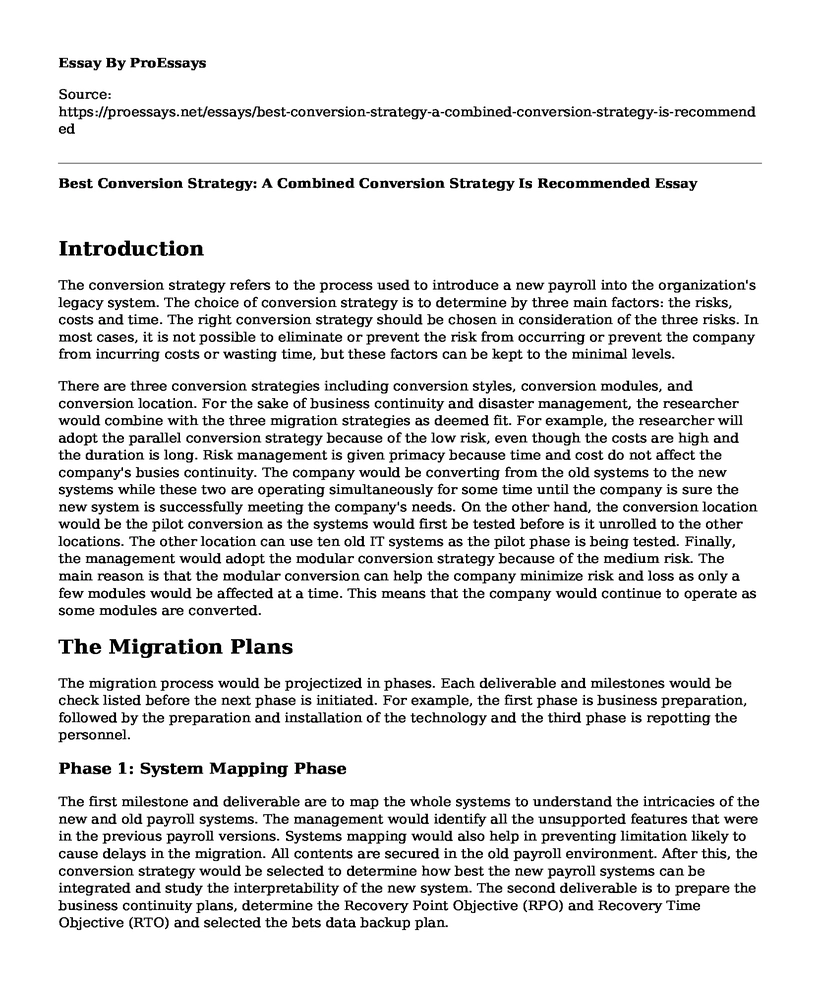Introduction
The conversion strategy refers to the process used to introduce a new payroll into the organization's legacy system. The choice of conversion strategy is to determine by three main factors: the risks, costs and time. The right conversion strategy should be chosen in consideration of the three risks. In most cases, it is not possible to eliminate or prevent the risk from occurring or prevent the company from incurring costs or wasting time, but these factors can be kept to the minimal levels.
There are three conversion strategies including conversion styles, conversion modules, and conversion location. For the sake of business continuity and disaster management, the researcher would combine with the three migration strategies as deemed fit. For example, the researcher will adopt the parallel conversion strategy because of the low risk, even though the costs are high and the duration is long. Risk management is given primacy because time and cost do not affect the company's busies continuity. The company would be converting from the old systems to the new systems while these two are operating simultaneously for some time until the company is sure the new system is successfully meeting the company's needs. On the other hand, the conversion location would be the pilot conversion as the systems would first be tested before is it unrolled to the other locations. The other location can use ten old IT systems as the pilot phase is being tested. Finally, the management would adopt the modular conversion strategy because of the medium risk. The main reason is that the modular conversion can help the company minimize risk and loss as only a few modules would be affected at a time. This means that the company would continue to operate as some modules are converted.
The Migration Plans
The migration process would be projectized in phases. Each deliverable and milestones would be check listed before the next phase is initiated. For example, the first phase is business preparation, followed by the preparation and installation of the technology and the third phase is repotting the personnel.
Phase 1: System Mapping Phase
The first milestone and deliverable are to map the whole systems to understand the intricacies of the new and old payroll systems. The management would identify all the unsupported features that were in the previous payroll versions. Systems mapping would also help in preventing limitation likely to cause delays in the migration. All contents are secured in the old payroll environment. After this, the conversion strategy would be selected to determine how best the new payroll systems can be integrated and study the interpretability of the new system. The second deliverable is to prepare the business continuity plans, determine the Recovery Point Objective (RPO) and Recovery Time Objective (RTO) and selected the bets data backup plan.
Phase 2: The Second Phase Is the Migration Phase.
All the necessary hardware and software would be installed and tested to determine the functionality of the new systems. After the system is installed and both beta and alpha tests are completed, the data would be converted concurrently with data backup. It is important to note that data would be back up in the cloud to maximize throughput and minimize downtime and loss. It is at this phase that the parallel conversion would be adopted. For example, the payroll from each department would be mapped and reviewed separately and concurrently to save time. The company has several branches and in each Branch, a pilot phase would be initiated and if the pilot phase is successful, the new payroll would be rolled out to all the branches. Because the organization is large and complex, the payroll software would be separated into smaller manageable modules and the installation process would be done by modules.
The key modules include:
- Employee leave management systems,
- Employee allocate management systems
- Loan term and conditions systems
- Reporting systems
- Employee leave and management systems,
- Employee TA/DA management system
- Payroll center management system
- The third phase is the personnel support phase
The first milestone in this phase is to review and amend the management policies that might collide with the new payroll. This would be followed by employee training and development. All employees would be trainee do how to operate and interact with the new payroll sissy's. The management would also assess the cost and associated benefit of the new systems and if the review is positive, the employees would be motivated to adopt the new systems. This phase would also help in presenting employee resistance.
Cite this page
Best Conversion Strategy: A Combined Conversion Strategy Is Recommended. (2022, Jul 15). Retrieved from https://proessays.net/essays/best-conversion-strategy-a-combined-conversion-strategy-is-recommended
If you are the original author of this essay and no longer wish to have it published on the ProEssays website, please click below to request its removal:
- Microsoft Versus Apple - Essay Sample
- Essay on Important Changes for Businesses and Managers as They Relate to SOX
- Advice to MB on the Potential Liability to the Unfair Dismissal
- Business Planning and the Budget Paper Example
- Essay Sample on Leadership Philosophy
- Global Companies: Tapping Into the Global Marketplace With Expert Assistance - Essay Sample
- Essay on IKEA's Sustainability Strategy: How Well Is It Doing?







